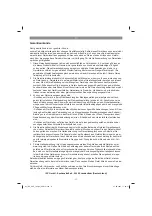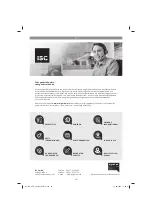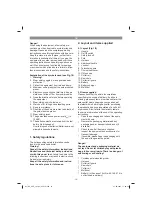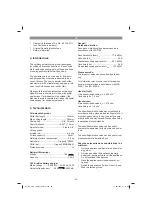
GB
- 24 -
Sawing o
ff
larger and longer branches
(Fig. 17):
Carry out a relief cut when working on larger
branches.
Start by sawing through 1/3 of the branch diame-
ter (a) from the bottom to the top with the top side
of the cutter rail. Then saw towards the
fi
rst cut (b)
from the top to the bottom with the bottom side of
the cutter rail.
Saw o
ff
longer branches in several steps to keep
control over the impact location.
Kick-back!
The term “kickback” describes what happens
when the running chainsaw suddenly kicks up-
ward and backward. Usually, this is caused by
contact between the tip of the cutter rail and the
workpiece or the saw chain becoming trapped.
In the event of kickback, large forces occur sud-
denly and violently. As a result, the chainsaw
usually reacts uncontrollably. This can often result
in very serious injuries to the worker or persons in
the vicinity. The risk of kickback is at its greatest
when the saw is positioned for a cut in the region
of the tip of the cutter rail, as the leverage e
ff
ect is
greatest there. It is therefore safest to position the
saw as
fl
at as possible.
Warning!
•
Make sure that the chain tension is always
correctly adjusted.
•
Only use a chainsaw if it is in perfect working
order.
•
Only work with a saw chain that has been
properly sharpened in accordance with the
instructions.
•
Never cut with the upper edge or the tip of the
cutter rail.
•
Always hold the chainsaw firmly with both
hands.
Cutting wood which is under tension
Special care is required when cutting wood which
is under tension. Wood which is under tension
from which it is released by cutting may in some
cases react completely unpredictably and un-
controllably. In the worst case this could result in
extremely severe or even fatal injuries. This type
of work must only be performed by persons who
have been specially trained.
8. Cleaning, maintenance and
ordering of spare parts
Danger!
Remove the battery pack before doing any
cleaning and maintenance work.
8.1 Cleaning
•
Regularly clean the clamping mechanism by
blowing it out with compressed air or cleaning
it with a brush. Do not use tools for cleaning.
•
Keep the handles free of grease so that you
can maintain a firm grip.
•
Clean the equipment as required with a damp
cloth and, if necessary, mild washing up li-
quid.
•
Never immerse the equipment in water or
other liquids in order to clean it.
8.2 Maintenance
Use only saw chains and cutter rails approved by
the manufacturer. These are listed in section 4
“Technical data” or are available as accessories
(see section 8.3 “Ordering spare parts”). The use
of spare parts which are not approved by the ma-
nufacturer could result in very serious injuries.
Replacing the saw chain and cutter rail
The cutter rail needs to be replaced if the guide
groove of the cutter rail is worn; Proceed as de-
scribed in the section “Assembly of the cutter rail
and the saw chain”.
Checking the automatic chain lubrication
You should check the operation of the automatic
chain lubrication system on a regular basis in or-
der to guard against overheating and the associ-
ated damage to the cutter rail and the saw chain.
To do this, point the tip of the cutter rail towards
a smooth surface (board, section of a cut tree)
and allow the chainsaw to run. If an increasing oil
trace becomes evident during this process then
the automatic chain lubrication system is working
properly. If no clear oil trace is evident then please
refer to the corresponding instructions in “Troub-
leshooting”. If the information contained there still
fails to remedy the situation then please contact
our service department or another similarly quali-
fi
ed workshop.
Notice!
Do not actually touch the surface with
the tip of the cutter rail when performing this test.
Keep a safe distance (approx. 20 cm).
Anl_KX_AHE_1820_Li_SPK13.indb 24
Anl_KX_AHE_1820_Li_SPK13.indb 24
27.05.2021 11:21:00
27.05.2021 11:21:00
















































